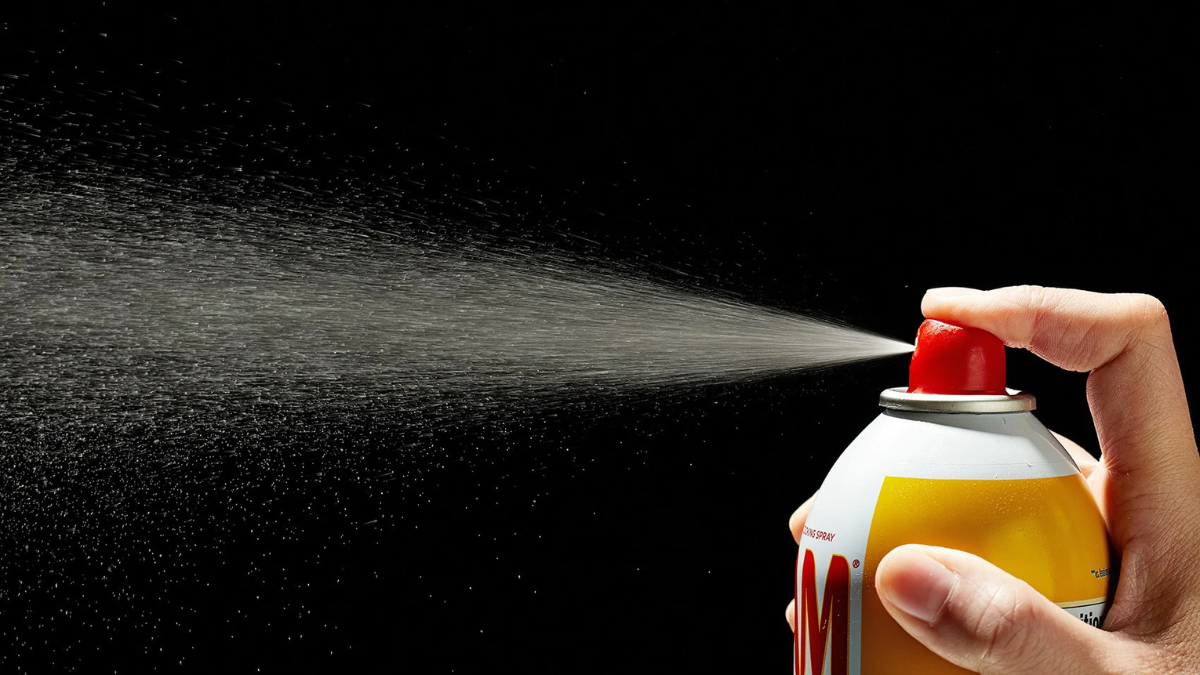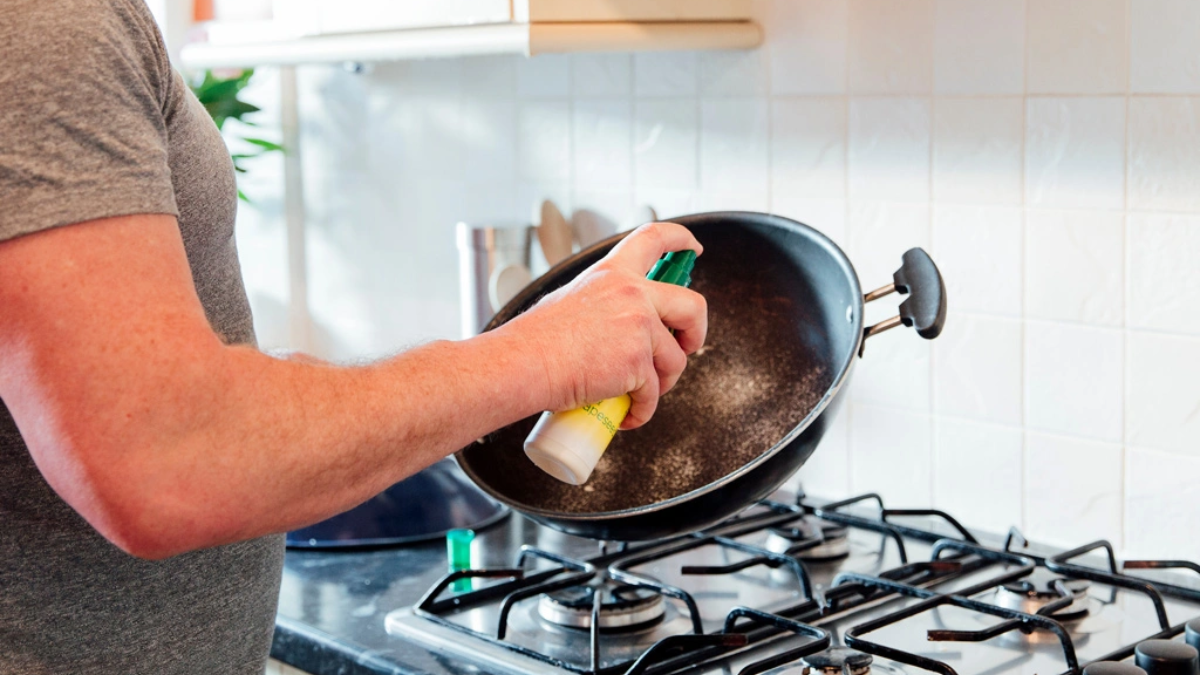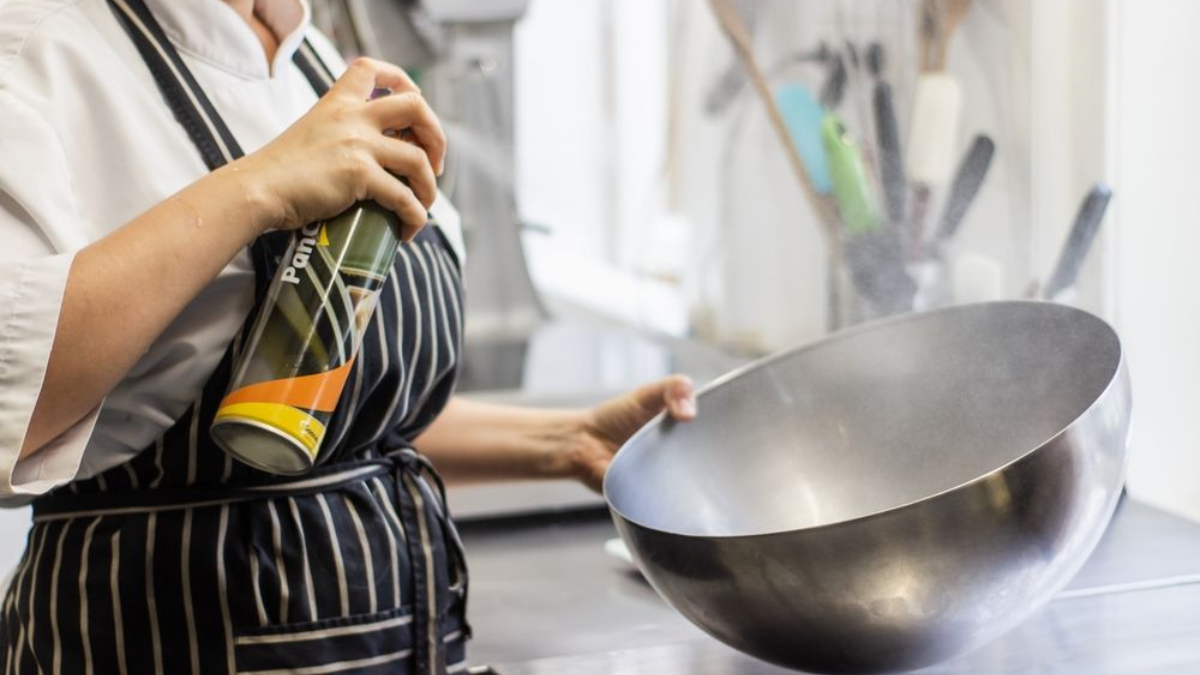Our ancestors began to cook their food between one and two million years ago. Thus, cooking spray is a rather new development in the overall scheme. Cooking spray is oil in a can, but it also includes emulsifier lecithin, an antifoaming ingredient called dimethyl silicone, and a fuel-like butane or propane. When the aerosol spray is released, it covers your object with a thin layer, preventing food from sticking.
Cooking spray, often known as nonstick cooking spray, is a sprayable oil used to make surfaces simpler to clean after cooking or to keep food from clinging to them while it is being cooked. Greasing a surface with lard or oil can yield similar results, but the cooking spray can be a significant time-saver when working with irregular surfaces.
What is Exactly Nonstick Spray or Cooking Spray?
There are various uses for nonstick cooking spray in the kitchen. Lecithin, which emulsifies, lubricates, and fuels such as food-grade alcohol, nitrous oxide, carbon dioxide, or propane, combine chemically to make nonstick sprays. It’s helpful in sticky culinary scenarios like making it easier to slide cookies off the baking sheet, making measuring molasses or honey less sticky, slicing dried fruit, and mold rice cereal snacks and meatballs. It makes cleaning a cheese grater simple and stops tomato-based sauces from staining plastic containers.
Varieties
A cooking spray with a high heat formula exists that “resists residue build-up.” Canola, coconut, and olive oil make several cooking spray types, baking flour, and a buttery flavor. There are also products produced using non-GMO oils, such as sunflower oil. You may always manufacture your cooking spray using a mister and the oil of your choice if you’re concerned about additives or the sticky residue that won’t go away when using nonstick cooking spray.
Taste
The nonstick cooking spray has a relatively faint flavor, though some individuals could perceive a chemical flavor. Many different brands claim to taste like butter or olive oil or are prepared with other types of oils. The objective of any spray is to prevent stickiness, and the flavor shouldn’t be too strong or overpower the food.
Is Cooking Spray Different than Baking Spray?
So how do cooking spray and baking spray compare? Well, that depends on who you ask since many individuals frequently confuse the terms “cooking spray” and “baking spray.”
On the other hand, in addition to their original formula, some companies, like Pam, also produce goods expressly for baking. To further guarantee that baked goods are released from pans without sticking, these baking sprays frequently incorporate flour in their formulations.
For my infrequent baking tasks, I use my ordinary can of cooking spray, and it works perfectly for me! However, if you bake frequently and want to ensure that your cake and cookie recipes come out beautifully, a baking spray that contains flour might be your best bet.
The Cooking Spray has a Surprising Number of Uses
Although you undoubtedly already use cooking spray to prevent food from sticking to your pots and pans, this pantry essential has many other uses. Get the most usage possible out of that can you have sitting in your pantry; you may discover that you have been underutilizing it all along.
- Prevent Plastic Food Storage Containers from Staining: You’ll wish you had known this advice sooner if your plastic food storage containers are permanently orange due to tomato sauce: Cooking spray should be applied to a container’s interior before you fill it with food. This creates a barrier between the food and the plastic, preventing the formation of bothersome stains in the first place.
- Spread Sticky Ingredients with a Spatula: Spreading sticky things, such as marshmallow desserts, with silicone spatulas after spraying them with cooking spray.
- Grating Cheese: Spraying your grater with a little cooking spray beforehand might help prevent your cheese from becoming a clumpy mess as you grate it. This will greatly improve the smoothness of the cheese grating and make cleanup much simpler.
- Measure Sticky Ingredients: Sticky ingredients (such as peanut butter, honey, or syrup) can be difficult to remove from the measuring cup completely. Try cooking by spraying the measuring cup before scraping it out with a spoon or spatula; the ingredient will now glide straight out!
- Prevent Water from Boiling Over: Before starting to boil water for pasta, potatoes, etc., apply cooking spray inside of the pot. This will lessen the likelihood of the water overflooding. You can also spray a little more water on the water’s surface if you see your water level starting to rise a bit too much.
- Prevent Knives from Sticking: Do you dislike when food particles stick to your knife as you chop? The next time you prepare food, lightly spray your blade with cooking spray to prevent sticking.
- Hold the Parchment Paper in Place: Although lining your pans with parchment paper reduces cleanup time, it can be unpleasant if the paper keeps moving. To help the parchment paper stick to the pan, lightly put cooking spray on it first.
- Use in Place of Oil for Baking and Broiling: You can use cooking spray directly on your food, which may surprise you. Using cooking spray rather than a brush to apply oil to your food will help you use less oil and achieve a more uniform coating for seasonings to stick to. Before baking or broiling breaded chicken or fish, try spraying it with cooking spray; this will give it a crunch and a gorgeous golden-brown hue. If you prefer the flavor of olive oil over the conventional canola oil spray, there are sprays with an olive oil basis.
- Shape Patties: Creating the patties is the most difficult portion of making burgers for me because they frequently stick to my hands. This is a major game-changer: To prevent sticking, apply cooking spray on your hands before forming the patties. The same technique can be used to roll meatballs.
- Protect Rising Dough: To stop the dough from adhering to and ripping the plastic wrap when proving dough in a bowl covered with plastic wrap, try cooking and spraying the inside.
Is Cooking Spray Healthy?
Cooking sprays may make it easy to grease cookware and baking dishes, but doing so may affect the flavor and satisfaction of the food and expose you to additives that may be found in many aerosol-based sprays.
- It’s crucial to study the ingredients list when selecting a frying spray. Although many manufacturers make their main constituent true plant-based oils like canola, certain brands could combine oils and artificial flavorings.
- Traditional aerosol cooking sprays also include an emulsifier (typically soy lecithin), an antifoaming agent, and a liquid fuel like propane or another substance in addition to oil.
- More recent sprays on the market replace the antifoaming ingredient with carbon dioxide as the fuel. Some goods employ non-aerosol technology, which prevents the mixing of gas and oil inside the can.
- The Food and Drug Administration (FDA) considers cooking sprays safe for eating. Avoiding cooking sprays may be your best option if you prefer to keep away from the ingredients in them.
What are the Substitutes of Cooking Spray?
Here are some substitutes for cooking spray:
Parchment Paper
These days, more people use parchment or baking paper in their kitchens. Amazingly, homemakers in various parts of the world even utilized newspapers in the past, before the invention of parchment paper alone (very much undesirable today).
Suppose you merely use the price of oil as a comparison. In that case, parchment paper is not an expensive kitchen aid and is unquestionably more than just a practical and beneficial domestic aid. The parchment paper is unquestionably the healthiest alternative because it doesn’t require further oiling and has a thin layer of wax-coated coating on both sides.
Butter and Lard
These two are great and effective substitutes for cooking spray. It spreads easily with your fingers, a silicone kitchen brush, or a piece of kitchen towel once it has somewhat melted. One thing to remember when substituting butter for the cooking spray is to use it so that the thinnest layer is applied. This is due to its flavor; if used excessively, it can drastically alter the flavor of your meal or dessert. To make things easier, it is advised to use butter for baked items and lard for roasted meat and vegetables.
Regular Oil Or Olive Oil
Simple, healthful cooking oil that can be heated to high temperatures is another excellent alternative to the cooking spray. It might be whatever oil you have in your kitchen, such as avocado or sunflower.
To ensure you don’t include extra fat in your dish, spread a thin layer of oil to the frying pan or baking sheet using a simple kitchen towel. Once more, use caution when measuring the amount, especially if you are using olive oil, as too much of it will drastically alter the flavor of the food.
On the other hand, a few drops extra will work wonders for the flavor and outcome if you use it to prepare veggies and particularly fish dishes.
Dusting with Flour
This advice shouldn’t come as a surprise! If you’ve ever seen this technique used in a recipe, trust that it works wonders for your food without running the risk of losing flavor. There are two ways to apply this excellent replacement.
According to your recipe, the first step is to spread a thin layer of oil, butter, olive oil, or any other “greaser” on the surface. Add a small amount of flour, shake the pan or tray to distribute it evenly, and then toast the remaining flour.
This is an excellent way to stop bunt cakes, muffins, or any other type of pastry from sticking to the bottom. Additionally, you may make this wonderful spreadable combination ahead of time, store it, and then use it whenever you need a convenient, quick, and easy replacement for cooking spray.
Homemade Non-Stick Cooking Spray
Homemade nonstick cooking spray is one of the simplest and most affordable alternatives you can employ. You only need a refillable spray bottle or plant mister bottle. Two teaspoons of canola oil can be used, along with one cup of water and two tablespoons less. However, remember that it is not advised to leave it out too long as it may go rancid. This DIY recipe can also be made with standard or olive oil. The greatest choice for a one-time fix is this one.
Conclusion
Cooking spray is a commercial product that applies cooking oil or another lubricant to the cookware’s surface using pressured gas. A lubricant, a fuel, and an emulsifier combine the first two ingredients and are the three main components of cooking spray. The cooking spray uses pressure to spray cooking oil on cookware in a fine mist before cooking.
Once the cooking spray has been correctly put to the surface of a pot or pan, food items normally won’t stick to it. Cooking sprays assist in utilizing a small amount of cooking oil effectively, reducing calorie consumption as cooking oil is calorie-dense. These sprays cannot be utilized when using a lot of oil, like deep-frying.


